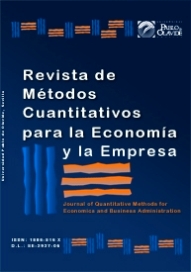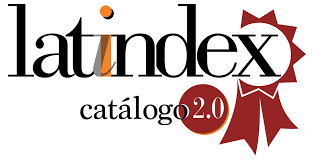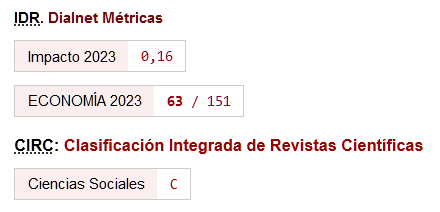Relationship between labor well-being and change management in a financial entity in the Department of Meta, Colombia
DOI:
https://doi.org/10.46661/rev.metodoscuant.econ.empresa.7844Keywords:
Organizational Management, Employee satisfaction, Financial entityAbstract
This study was conducted to analyze the relationship between well-being at work and change management among employees of a financial institution located in the department of Meta, Colombia. The information was collected via a questionnaire sent to all employees in 2021. A statistical and correlational analysis was carried out. The results show that (1) the majority of participants present high levels of well-being at work, (2) the sociodemographic characterization of the collaborators shows a greater presence of women (70%), and (3) the highest percentage of employees belong to the commercial field (53% ). In general, there are no significant differences in the employees’ perception of well-being at work and change management in the organization. The financial entity has implemented actions that generate well-being in employees, however, it is important to improve some aspects related to change management and continue advancing in policies that favor the reconciliation of family and work life.
Downloads
References
Anzola, P., Bayona, C., García, T. (2015). La generación de valor a partir de innovaciones organizativas: efectos directos y moderadores. Universia Business Review, 46, 70-93.
Arce, B., Sánchez, R., Ramírez, J. (2016). Estrategias competitivas organizacionales con responsabilidad social. Xalapa, Veracruz, México: Majoma Editorial.
Argyle, M. (1992). La psicología de la felicidad. Madrid, Spain: Alianza Editorial.
Armenteros, M., Guerrero, L., Noyola, F., Molina, V. (2012). Cultura organizacional y organización que aprende, un análisis desde la perspectiva de la innovación. Revista Internacional de Administración y Finanzas, 33-51.
Bakker, A., Hetland, J., Olsen, O., Espevik, R. (2019). Daily strengths use and employee wellbeing: the moderating role of personality. Journal of Occupational and Organizational Psychology, 92(1), 144-168.https://doi.org/10.1111/joop.12243 DOI: https://doi.org/10.1111/joop.12243
Bengat, J., Odenyo, M., Rotich, J. (2015). Organizational change and resistance dilemmas resolution approaches and mechanisms. International Journal of Economics, Commerce and Management, 3(2), 1-17.
Bonavia, T., Quintanilla, I. (1998). El efecto de los ingresos, el nivel jerárquico, la cultura empresarial y las creencias de los directivos sobre la satisfacción vital. Revista de Psicología del Trabajo y de las Intervenciones, 14(2), 217-231.
Calderón, G., Murillo, S., Torres, K. (2003). Cultura Organizacional y Bienestar Laboral. Cuadernos de Administración, 16(25), 109-137.
Capriotti, P. (1998). La comunicación interna. Reporte C&D-Capacitación y desarrollo, 13, 5-7.
Céspedes, J., Torres, K. (2017). Relación entre la motivación del personal y la gestión del cambio en la clínica Limatambo en Cajamarca, Cajamarca: Universidad Privada del Norte.
Chiavenato, I. (2011). Administración de recursos humanos, El capital humano de las organizaciones (Novena edición). Rio de Janeiro, Brasil: Elsevier Editora Ltda.
Coromoto, H., Villon, S. (2018). Motivación laboral elemento fundamental en el éxito. organizacional. Scientific, 3(7), 177 - 192.
https://doi.org/10.29394/Scientific.issn.2542-2987.2018.3.7.9.177-192 DOI: https://doi.org/10.29394/Scientific.issn.2542-2987.2018.3.7.9.177-192
Daniels, K., Watson, D., Nayani, R., Tregaskis, O., Hogg, M., Etuknwa, A., Semkina, A. (2021). Implementing practices focused on workplace health and psychological wellbeing: A systematic review. Social Science & Medicine 277, 113888.
https://doi.org/10.1016/j.socscimed.2021.113888 DOI: https://doi.org/10.1016/j.socscimed.2021.113888
De Faria, F. (2004). Desarrollo Organizacional, enfoque integral. México: Editorial Limusa SA Grupo Noriega Editores.
Demerouti, E., Bakker, A., Nachreiner, F., Schaufeli, W. (2001). The job demands - Resources model of burnout. Journal of Applied Psychology, 86, 499-512.https://doi.org/10.1037/0021-9010.86.3.499 DOI: https://doi.org/10.1037//0021-9010.86.3.499
Diener, E. (1994). "El bienestar subjetivo". Intervención psicosocial. Revista sobre Igualdad y Calidad de Vida, 3 (8), 67-113.
Diener, E. (1994). El bienestar subjetivo. Psychosocial Intervention, 3(8), 67-113.
Eaglebarger, S. (2017). Engaging employees beyond the office freebies. Strategic HR Review, 16(3), 112-116. https://doi.org/10.1108/SHR-03-2017- 0015. DOI: https://doi.org/10.1108/SHR-03-2017-0015
Echevarría, K., Ortega, R. (2017). percepción del bienestar laboral de los empleados: estudio comparativo según su género. Internacional Administración & Finanzas, 10(2) 17-27.
Egan, M., Bambra, C., Petticrew, M., Y Whitehead, M. (2009). Reviewing evidence on complex social interventions: appraising implementation in systematic reviews of the health effects of organisational-level workplace interventions. Journal of epidemiology and community health, 63(1), 4-11. https://doi.org/10.1136/jech.2007.071233 DOI: https://doi.org/10.1136/jech.2007.071233
Farias, S. (2010). Internal marketing (IM): a literature review and research propositions for service excellence. Brazilian Business Review, 7(2), 99-115.
https://doi.org/10.15728/bbr.2010.7.2.6 DOI: https://doi.org/10.15728/bbr.2010.7.2.6
Ferrer, R. (2015). La influencia del factor humano, el liderazgo y la cultura de las organizaciones en los procesos de implementación y gestión del cambio organizacional. Rev. Internacional de Investigación en Ciencias Sociales 11 (1) 102-114 DOI: https://doi.org/10.18004/riics.2015.julio.102-114
https://doi.org/10.18004/riics.2015.julio DOI: https://doi.org/10.18004/riics.2015.julio
García Rubiano, M., y Forero Aponte, C. (2016). Calidad de vida laboral y la disposición al cambio organizacional en funcionarios de empresas de la ciudad de Bogotá - Colombia. Acta Colombiana de Psicología, 19(1), 79-90. https://doi.org/10.14718/ACP.2016.19.1.5 DOI: https://doi.org/10.14718/ACP.2016.19.1.5
García, C., González, I. (2000). La categoría bienestar psicológico, su relación con otras categorías sociales. Revista Cubana de Medicina Integral, 16 (6), 586-592.
García, M. (2002). El bienestar subjetivo. Escritos de Psicología, 6, 18-39.https://doi.org/10.24310/espsiescpsi.vi6.13409 DOI: https://doi.org/10.24310/espsiescpsi.vi6.13409
Gouveia, I. (2017). Strategy, Organizational Change and Organizational Resilience. Cuadernos Ebape.Br, 15, Doi: 10.1590/1679- 395170357.
Hermosa, A. (2018). Características laborales y compromiso en el trabajo: explorando el bienestar laboral. Estudios de Administración, 1, 20-31.
Hofmans, J., De Gieter, S., Pepermans, R. (2013). Individual differences in the relationship between satisfaction with job rewards and job satisfaction. Journal of Vocational Behavior, 82(1), 1-9. https://doi.org/10.1016/j.jvb.2012.06.007 DOI: https://doi.org/10.1016/j.jvb.2012.06.007
Hosie, P., Sevastos, P. (2009). Does the "happy‐productive worker thesis apply to managers?. International Journal of Workplace Health Management, 2 (2), 131-160.https://doi.org/10.1108/17538350910970219 DOI: https://doi.org/10.1108/17538350910970219
Huang, L., Ahlstrom, D., Lee, A., Chen, S., Hsieh, M. (2016). High performance work systems, employee wellbeing, and job involvement: an empirical study. Personnel Review, 45(2), 296-314.https://doi.org/10.1108/PR-09-2014-0201 DOI: https://doi.org/10.1108/PR-09-2014-0201
Jiménez, G., Rivera, A., Gaibao, M. (2019). Las condiciones de bienestar laboral en una empresa del sector hotelero. Estudio de caso en Medellín, Colombia. Prospectiva. Revista de Trabajo Social e intervención social (28), 203-226.
https://doi.org/10.25100/prts.v0i28.7225 DOI: https://doi.org/10.25100/prts.v0i28.7225
Karanges, E., Johnston, K., Beatson, A., Lings, I. (2015). The influence of internal communication on employee engagement: A pilot study. Public Relations Review, 41(1), 129-131. https://doi.org/10.1016/j.pubrev.2014.12.003 DOI: https://doi.org/10.1016/j.pubrev.2014.12.003
Korte, R., Chermack, T. (2007). Changing organizational culture with scenario planning, Journal of Futures, 39(6), 645-656.https://doi.org/10.1016/j.futures.2006.11.001 DOI: https://doi.org/10.1016/j.futures.2006.11.001
Kossek, E., Perrigino, M., Lautsch, B. (2023). Work-Life flexibility policies from a boundary control and implementation perspective: A review and research framework. Journal of Management, 49(6), 2062-2108.https://doi.org/10.1177/01492063221140354 DOI: https://doi.org/10.1177/01492063221140354
Kundi, M., Ikramullah, M., Iqbal, M., Ul-Hassan, F. (2018). Affective commitment as mechanism behind perceived career opportunity and turnover intentions with conditional effect of organizational prestige. Journal of Managerial Sciences, 11(3) 65-82 . https://www.researchgate.net/publication/327013363_Affective_Commitment_as_Mechanism_behind_Perceived_Career_Opportunity_and_Turnover_Intentions_with_Conditional_Effect_of_Organizational_Prestige
Lamontagne, A. D., Keegel, T., Louie, A. M., Ostry, A., & Landsbergis, P. A. (2007). A systematic review of the job-stress intervention evaluation literature, 1990-2005. International journal of occupational and environmental health, 13(3), 268-280. https://doi.org/10.1179/oeh.2007.13.3.268 DOI: https://doi.org/10.1179/oeh.2007.13.3.268
Mainardes, E., Rodrigues, L., Teixeira, A. (2019). Effects of internal mar¬keting on job satisfaction in the banking sector. International Journal of Bank Marketing, 37(5), 1313-1333. https://doi.org/10.1108/IJBM-07-2018-0190 DOI: https://doi.org/10.1108/IJBM-07-2018-0190
Martins, E., Terblanche, F. (2003). Building organizational culture that simulates creativity and Innovation. European Journal of Innovation Management, 6(1): 64-74.https://doi.org/10.1108/14601060310456337 DOI: https://doi.org/10.1108/14601060310456337
Men, L., Yue, C. (2019). Creating a positive emotional culture: Effect of internal communication and impact on employee supportive be¬haviors. Public relations review, 45(3), 101764. https://doi.org/10.1016/j.pubrev.2019.03.001 DOI: https://doi.org/10.1016/j.pubrev.2019.03.001
Montenegro, J. (2019). Análisis del bienestar laboral en Colombia, segmento en sus diferentes sectores productivos. Bogotá: Institución Universitaria Politécnico Grancolombiano.
Moran, J., Brightman, B. (2001). Leading organizational change. Career Development International, 6(2), 111-118.
https://doi.org/10.1108/EUM0000000005581 DOI: https://doi.org/10.1108/EUM0000000005581
Murillo, G. (2009). Conocimiento e innovación en los procesos de transformación organizacional: El caso de las organizaciones bancarias en Colombia. Estudios Gerenciales, Universidad ICESI, 71-100.https://doi.org/10.1016/S0123-5923(09)70081-6 DOI: https://doi.org/10.1016/S0123-5923(09)70081-6
Naoler, A., Tushman, M. (1999). Beyond the charismatic leader: Leadership and organizational change. California Management Review, 32(2), 77-97.https://doi.org/10.2307/41166606 DOI: https://doi.org/10.2307/41166606
Orengo, V., Grau, R., Peiró, J. (2002). La innovación tecnológica como proceso de cambio organizacional. Revista de Psicología del Trabajo y las Organizaciones, Colegio Oficial de Psicólogos de Madrid, 5-38.
Pardo del val, M., Martínez, C. (2003). Resistance to change: a literature review and empirical study. Management Decision, 41 (2), 148-155.https://doi.org/10.1108/00251740310457597 DOI: https://doi.org/10.1108/00251740310457597
Paredes, C. (2017). Relaciones interpersonales en el bienestar laboral. Universidad Mariana - Boletín Informativo CEI, 4(2), 18-22.
Quirant, A., Ortega, A. (2006). El cambio organizacional: La importancia del factor humano para lograr el éxito del proceso de cambio. Revista de Empresa, (18) 50-62. https://gc.scalahed.com/recursos/files/r161r/w21929w/U2S5L3.pdf
Racero, V., Álvarez, A. (2014). Contrato psicológico y bienestar laboral. 95-105.
Raj, A. (2020). Employee Well-being through Internal Branding: An In¬tegrated Approach for Achieving Employee-based Brand Outcomes. Global Business Review, 21(4), 1065-1086. https://doi.org/10.1177/0972150918779161 DOI: https://doi.org/10.1177/0972150918779161
Ramos, C. (1991). La comunicación: un punto de vista organizacional. Trillas.
Recalde, M., Glaría, A. (2015). Comunicación interna y empre¬sa. Una puerta abierta hacia la creatividad e innovación. Creatividad y sociedad: revista de la Asociación para la Creatividad, (23), 161-181.
Richardson, K. M., & Rothstein, H. R. (2008). Effects of occupational stress management intervention programs: a meta-analysis. Journal of occupational health psychology, 13(1), 69-93. https://doi.org/10.1037/1076-8998.13.1.69 DOI: https://doi.org/10.1037/1076-8998.13.1.69
Rieley, J., Clarkson, I. (2001). The impact of change on performance. Journal of Change Management, 2(2), 160-172.https://doi.org/10.1080/714042499 DOI: https://doi.org/10.1080/714042499
Robbins, S. (1994). Comportamiento organizacional: conceptos, controversias y aplicaciones, México, Prentice Hall.
Rogala A., Bialowas S. (2016). Functions and Objectives of Internal Commu¬nication. En Rogala A., y Bialowas S. Communication in Organizational Environments (65-97). Palgrave Macmillan.
https://doi.org/10.1057/978-1-137-54703-3_3 DOI: https://doi.org/10.1057/978-1-137-54703-3_3
Saks, A. (2006). Antecedents and consequences of employee engagement. Journal of Managerial Psychology, 21(7), 600-619. https://doi.org/10.1108/02683940610690169 DOI: https://doi.org/10.1108/02683940610690169
Salanova, M., Llorens, S., Cifre. E., Martínez, I. (2012). We need a hero! Toward a validation of the Healthy and Resilient Organization (HERO) Model. Group & Organization Management, 37(6), 785-822.https://doi.org/10.1177/1059601112470405 DOI: https://doi.org/10.1177/1059601112470405
Serrat, M. (2017). Liderando el ¿bienestar? Laboral, orden o caos. Barcelona: Bosch Editor.
Sharma, P., Kong, T., Kingshott, R. (2016). Internal service quality as a driver of employee satisfaction, commitment and performance: exploring the focal role of employee well-being. Journal of Service Management, 27(5), 773-797.https://doi.org/10.1108/JOSM-10-2015-0294 DOI: https://doi.org/10.1108/JOSM-10-2015-0294
Shimazu, A., Schaufeli, W.B., Kamiyama, K., Kawakami, N. (2015). Workaholism vs work engagement: the two different predictors of future well-being and performance. International Journal of Behavioral Medicine, 22(1), 18-23. https://doi.org/10.1007/s12529-014-9410-x DOI: https://doi.org/10.1007/s12529-014-9410-x
Smith, L. (2005). Resistance to change Recognition and responses. Library Management, 26(819), 519-522.https://doi.org/10.1108/01435120510631800 DOI: https://doi.org/10.1108/01435120510631800
Stake, R. E. (1995). Investigación con estudio de casos. Madrid, Morata.
Supeli, A., Creed, P. (2015). The longitudinal relationship between protean career orientation and job satisfaction, organizational commitment, and intention-to-quit. Journal of Career Development, 43(1), 66-80.https://doi.org/10.1177/0894845315581686 DOI: https://doi.org/10.1177/0894845315581686
Tisu, L., Lupșa, D., Vîrgă, D. Rusu, A. (2020). Personality characteristics, job performance and mental health the mediating role of work engagement. Personality and Individual Differences, 153(15) https://doi.org/10.1016/j.paid.2019.109644 DOI: https://doi.org/10.1016/j.paid.2019.109644
Torres, D., Arce, L., Ibargüen, H. (2020). El aporte de los beneficios sociales a la motivación laboral en los hoteles Pymes: Caso Villavicencio, Colombia. Económicas, 41(1), 9-24. https://doi.org/10.17981/econcuc.41.1.2020.Econ.1 DOI: https://doi.org/10.17981/econcuc.41.1.2020.Econ.1
Turban, D., Yan, W. (2016). Relationship of eudaimonia and hedonia with work outcomes. Journal of Managerial Psychology,31(6), 1006-1020.https://doi.org/10.1108/JMP-07-2015-0271 DOI: https://doi.org/10.1108/JMP-07-2015-0271
Veenhoven, R. (1994). El estudio de la satisfacción con la vida. Intervención Psicosocial, 3, 87-116.
Villafañe, J. (2000). Imagen positiva. Gestión estratégica de la imagen de las empresas. Pirámide.
Wang, W., Mather, K., Seifert, R. (2018). Job insecurity, employee anxiety, and commitment: the moderating role of collective trust in management. Journal of Trust Research, 8(2), 220-237.https://doi.org/10.1080/21515581.2018.1463229 DOI: https://doi.org/10.1080/21515581.2018.1463229
Weber, P., Weber, J. (2001). Changes in employee perceptions during organizational change. Leadership & Organization Development Journal, 22(6), 291-300.https://doi.org/10.1108/01437730110403222 DOI: https://doi.org/10.1108/01437730110403222
Yin, R. (2003). Applications of Case Study Research, Applied Social Research Methods Series, Newbury Park, CA, Sage.
Zimmermann, A. (2000). Gestión del Cambio Organizacional. Caminos y Herramientas (Segunda Edición). Quito, Ecuador: Ediciones Ebya-Yala.
Downloads
Published
How to Cite
Issue
Section
License
Copyright (c) 2024 Dagoberto Torres-Flórez, lebsy Jazmin Hernandéz Calderón, Lisset Rocio Medina Moreno

This work is licensed under a Creative Commons Attribution-ShareAlike 4.0 International License.
Submission of manuscripts implies that the work described has not been published before (except in the form of an abstract or as part of thesis), that it is not under consideration for publication elsewhere and that, in case of acceptance, the authors agree to automatic transfer of the copyright to the Journal for its publication and dissemination. Authors retain the authors' right to use and share the article according to a personal or instutional use or scholarly sharing purposes; in addition, they retain patent, trademark and other intellectual property rights (including research data).
All the articles are published in the Journal under the Creative Commons license CC-BY-SA (Attribution-ShareAlike). It is allowed a commercial use of the work (always including the author attribution) and other derivative works, which must be released under the same license as the original work.
Up to Volume 21, this Journal has been licensing the articles under the Creative Commons license CC-BY-SA 3.0 ES. Starting from Volume 22, the Creative Commons license CC-BY-SA 4.0 is used.










